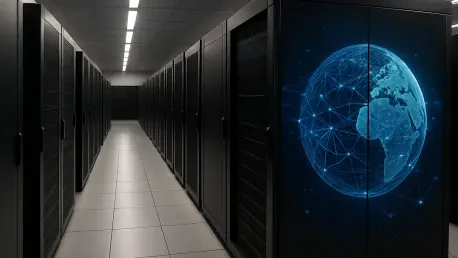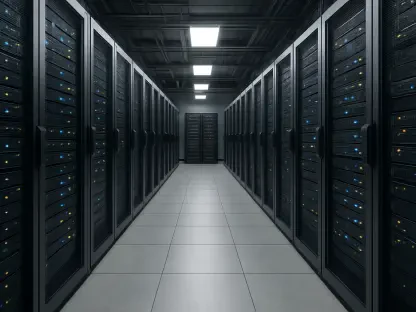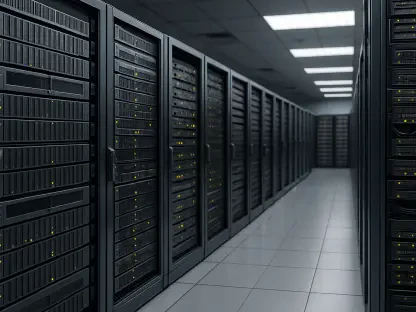In a world where solving humanity’s toughest challenges—such as decoding the mysteries of the universe or accelerating life-saving drug discovery—depends on raw computational power, one company stands at the forefront of this technological revolution. Hewlett Packard Enterprise (HPE) is pushing the boundaries of what’s possible with its cutting-edge Cray systems, delivering unprecedented power to tackle problems once deemed unsolvable. This isn’t just about faster machines; it’s about reshaping industries and enabling breakthroughs that impact lives globally. What drives this transformation, and how is HPE setting a new benchmark in high-performance computing (HPC)?
The significance of HPE’s advancements cannot be overstated, especially in an era where data fuels progress. Supercomputing is no longer a niche field reserved for academic research; it’s the engine behind artificial intelligence (AI), climate modeling, and enterprise innovation. With the explosion of data and the urgent need for sustainable tech solutions, HPE’s latest Cray systems address both performance and environmental demands, positioning the company as a leader in a fiercely competitive landscape. This story dives deep into the innovations, the voices behind them, and the real-world implications of these game-changing technologies.
Unveiling a New Era of Computational Power
HPE’s latest strides in supercomputing mark a pivotal shift in how complex global challenges are approached. The introduction of the Cray systems represents more than an upgrade; it’s a bold step into a realm where speed and efficiency converge to redefine possibilities. From simulating intricate scientific models to powering AI-driven insights, these systems are built to handle workloads that standard computing simply cannot match.
This transformation is driven by a clear vision: to deliver tools that not only perform at extraordinary levels but also adapt to the evolving needs of industries. HPE has recognized that the demand for computational power is skyrocketing, with applications spanning from healthcare to environmental science. The company’s focus on integrating cutting-edge hardware with forward-thinking designs ensures that its solutions are not just relevant today but poised for tomorrow’s challenges.
A striking example lies in how these advancements are already being eyed by major research institutions and enterprises. The ability to process massive datasets in record time is becoming a cornerstone for innovation, and HPE’s contributions are setting a high bar. This new era isn’t just about raw speed—it’s about creating systems that empower users to push beyond traditional limits.
Why Supercomputing Matters Now More Than Ever
The stakes for supercomputing have never been higher as industries grapple with data volumes that grow exponentially by the day. HPC systems are the backbone of modern progress, enabling everything from predicting weather patterns with pinpoint accuracy to training AI models that transform business operations. Without this level of computational strength, many of today’s critical advancements would stall.
Beyond pure performance, there’s a pressing need to address sustainability in tech infrastructure. Data centers, often power-hungry, face increasing scrutiny over their environmental impact, particularly in regions with stringent regulations. HPE’s emphasis on energy-efficient designs responds directly to this challenge, ensuring that high performance doesn’t come at the cost of ecological responsibility.
Moreover, the integration of AI into enterprise systems has amplified the need for adaptable supercomputing solutions. As organizations strive to harness machine learning for competitive advantage, the ability to process diverse workloads efficiently becomes paramount. HPE’s strategic focus on balancing power with practicality highlights why supercomputing is not just relevant but indispensable in shaping a smarter, more sustainable future.
Breaking Down HPE’s Game-Changing Cray Innovations
At the heart of HPE’s supercomputing revolution are the Cray Supercomputing GX5000 and K3000 storage systems, each designed with precision to address specific industry pain points. The GX5000, often dubbed a “pocket powerhouse,” slashes data center space requirements by 25% compared to its predecessor, the EX4000, while boosting power by an impressive 127% per compute slot. Its liquid cooling system, operating with warmer water at 40°C, not only reduces energy costs but also aligns with European sustainability standards.
Complementing this is the Cray Supercomputing Storage Systems K3000, which delivers a 39% increase in input/output operations per second (IOPS) per rack over the earlier E2000 model. As the industry’s first factory-built storage system incorporating open-source Distributed Asynchronous Object Storage (DAOS) software, it’s tailored for the converging demands of AI and HPC workloads. This combination of hardware and software innovation underscores HPE’s commitment to staying ahead of technological curves.
Further amplifying impact are projects like Discovery, a second-generation exascale supercomputer for Oak Ridge National Laboratory (ORNL), and the Lux AI cluster, a sovereign AI factory. Discovery leverages advanced AMD chipsets and high-speed Slingshot interconnects for unparalleled performance, while Lux offers cloud-like access for researchers, showcasing versatility. These initiatives illustrate how HPE tailors solutions to diverse needs, from raw computational might to accessible research platforms.
Voices of Innovation and Real-World Impact
Leadership at HPE provides insight into the meticulous development behind these technologies. Trish Damkroger, SVP and GM of HPC and AI at HPE, has shared that the GX5000’s design evolved over years to accommodate rising thermal design points and diverse silicon technologies, reflecting a direct response to industry shifts. This dedication to adaptability ensures that the systems meet current demands while anticipating future needs.
HPE’s dominance in the field is evident in its commanding presence on the Top500 list of the world’s most powerful supercomputers, securing six of the top 10 spots as of this year. This achievement, built on the foundation laid since acquiring Cray, speaks to a legacy of excellence. It’s not just about rankings; it’s about providing tools that drive tangible outcomes in scientific and industrial arenas.
Collaborations like those with ORNL on Discovery and Lux further highlight the real-world implications of HPE’s work. These projects equip researchers with the means to train sophisticated AI models and conduct exascale simulations, breaking barriers in understanding complex phenomena. Such partnerships demonstrate that HPE’s innovations are not confined to labs—they’re reshaping how knowledge is advanced on a global scale.
Practical Takeaways for the Future of Computing
For organizations and researchers planning the next phase of computational infrastructure, HPE’s approach offers valuable lessons. Scalability stands out as a priority; systems like the GX5000, with modular designs and hot-swappable components, simplify upgrades and maintenance, ensuring longevity. Adopting such flexible architectures can future-proof investments in a rapidly changing tech landscape.
Efficiency is another critical consideration. Embracing advanced cooling technologies, as seen in HPE’s designs, can significantly cut energy consumption without compromising performance. This is especially vital for data centers aiming to meet environmental goals while managing intensive workloads, providing a blueprint for sustainable growth.
Finally, addressing workload diversity is essential. Pairing specialized hardware, like the K3000 storage, with AI-optimized clusters such as Lux, allows for handling both traditional HPC tasks and emerging AI demands. Although systems based on the GX5000 are slated for delivery in 2027, starting to plan for integrated, sustainable solutions now can position any entity at the cutting edge of computational innovation.
Looking back, HPE’s journey with Cray systems marked a turning point in supercomputing, blending raw power with a keen eye on sustainability and adaptability. The strides made through innovations like the GX5000 and impactful projects with ORNL paved the way for a redefined approach to solving global challenges. As the landscape continues to evolve, the next steps for stakeholders involve investing in scalable, efficient technologies and fostering collaborations that drive progress. Staying ahead means not just keeping pace but anticipating the needs of tomorrow, ensuring that computational power remains a catalyst for positive change.









